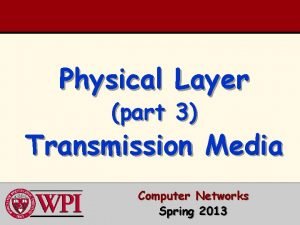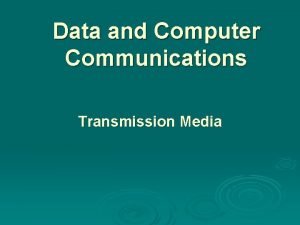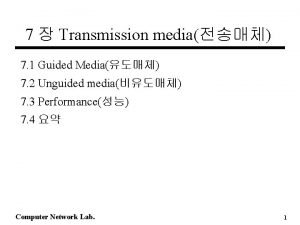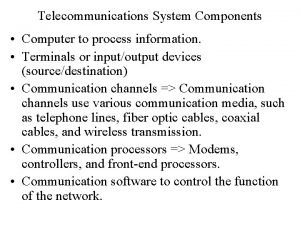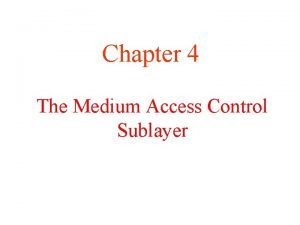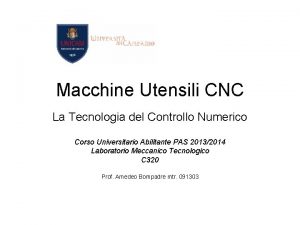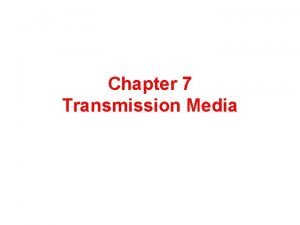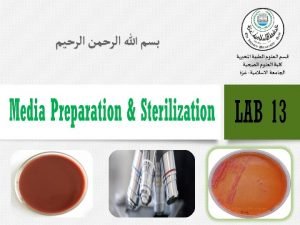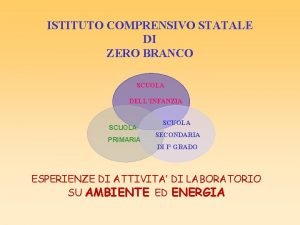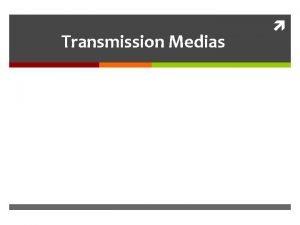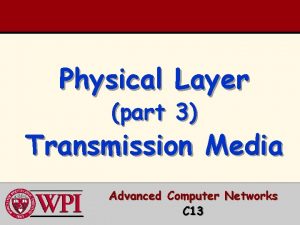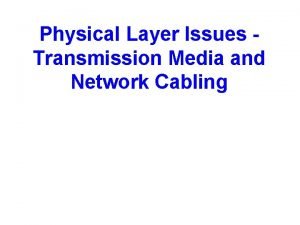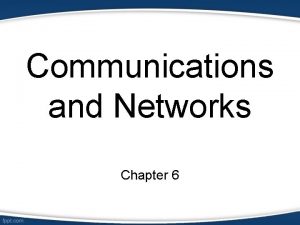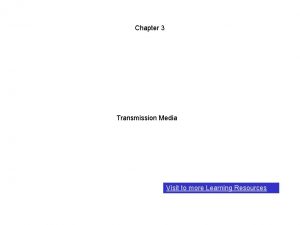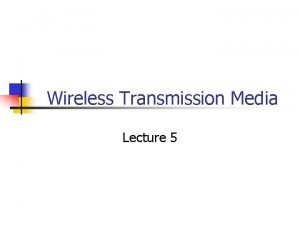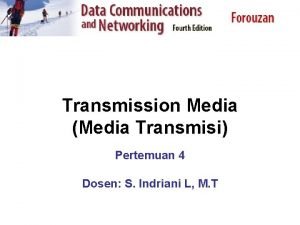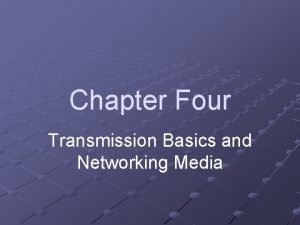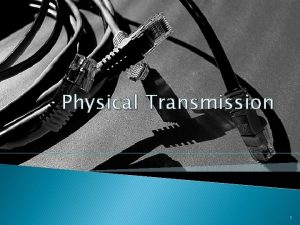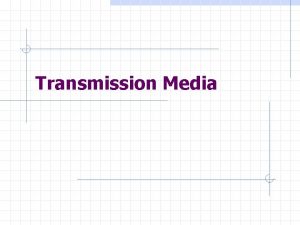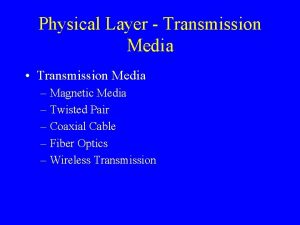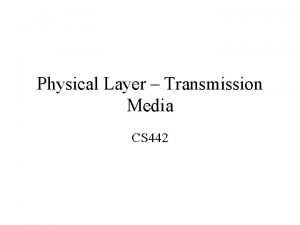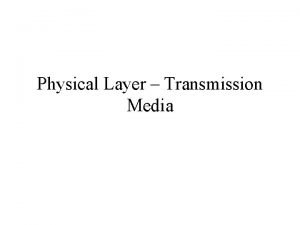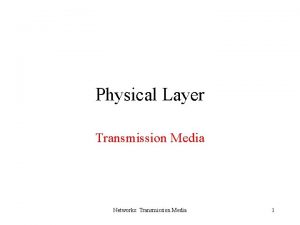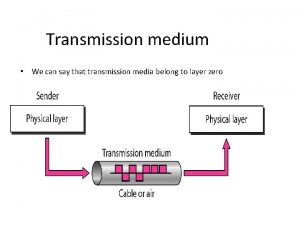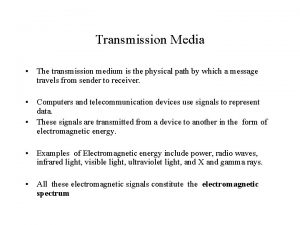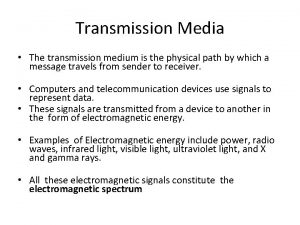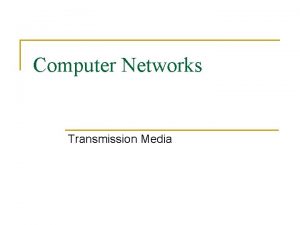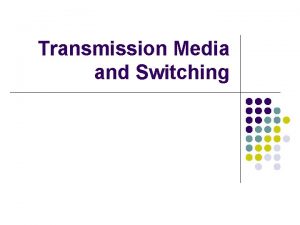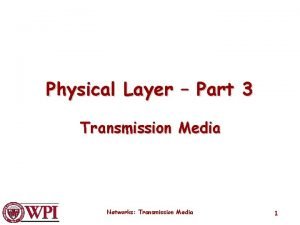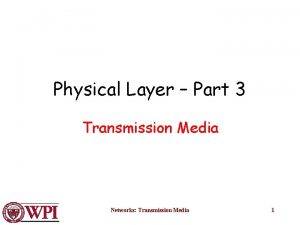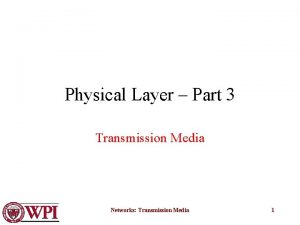Chapter 7 Transmission Media Transmission medium layer zero
































- Slides: 32

Chapter 7 Transmission Media

Transmission medium (layer zero) • A transmission media defined as anything that carry information between a source to a destination • Located below the physical layer and are directly controlled by the physical layer

GUIDED MEDIA • Guided media, which are those that provide a conduit from one device to another, include – Twisted—pair cable – Coaxial cable – Fiber—optic cable • Twisted –pair cables and coaxial cable: use metallic (copper) conductors that transport signals in the form of electric current • Optical fiber : transport signals in the form of the light












q Signal propagation can be in 2 modes q Multi mode • multiple beams from a light source • Can further be break down into two forms – Step-index » The density of the core remains constant from the center to the edges until it reaches the interface of the core and the cladding. » Beams in the middle travel in straight lines through the core and reach the destination without reflecting or refraction. » Other beams strike the interface of the core and cladding( )ﻏﻼﻑ at different angles causing the beams to reach the destination at different times – Graded-index » It is a fiber with varying density ( highest at the center of the core and decreases gradually to its lowest at the edge) » This difference causes the beams to reach the destination at regular intervals » can be used over distances of up to about 1000 meters q Single Mode • one beam of light • Uses step-index fiber and a highly focused source of light that limits beams to a small range of angles, all close to horizontal • Expensive because it is difficult to manufacture, but signal can be sent over many kilometers without spreading







Unguided Media – Radio • Wireless transmission of electrical waves • Includes AM and FM radio bands • Microwave is also a form of radio transmission. – Infrared • invisible light waves whose frequency is below that of red light. • Requires line of sight and are generally subject to interference from heavy rain. • Used in remote control units (e. g. , TV). – Microwave • • High frequency form of radio with extremely short wavelength (1 cm to 1 m). Often used for long distance Terrestrial transmissions and cellular telephones Requires line-of-sight.

Radio Transmission • are widely used because · · · easy to generate can travel long distances penetrate buildings easily excellent for a wide range of communication they are omnidirectional ( ﺍﻻﺗﺠﺎﻫﺎﺕ )ﻣﺘﻌﺪﺩ

Radio Transmission • The properties of radio waves are frequency dependent – low frequencies • radio waves pass through obstacles well • power of signal falls off sharply over distance – high frequencies • radio waves tend to travel in straight lines • bounce off obstacles • absorbed by rain – at all frequencies • subject to interference from electrical equipment • interference between users • therefore highly regulated

Infra-red • • • short-range communication (VCR remotes) cheap do not pass through solid objects will not interfere with a similar system in adjacent rooms better security against eavesdroppers

Microwave q Requires line-of-sight transmission & reception equipment Transmission is straight (from antenna-to-antenna) q Signals propagate in one direction at a time. q Two frequencies are required for 2 -way communication q For a telephone conversation we need one frequency for transmitting & another frequency for receiving. q Each frequency requires its own transmitter & receiver. q Now both are combined in a single piece called transceiver. q To increase distance served, repeaters installed with each antenna. q A signal received by one antenna is converted back into transmittable form and relayed to the next antenna.

Terrestrial Microwave

Satellite q Same as the terrestrial microwave, with a satellite acting as a super tall antenna and repeater. Geosynchronous Satellites q Line-of-sight propagation requires sending & receiving antennas be locked onto each other’s location all times. q To ensure constant communication, satellite must move at same speed as the earth so it seems to remain fixed above a certain spot. q This satellite called Geosynchronous. q Transmission from the earth to satellite is called uplink. q Transmission from the satellite to earth is called Downlink

Satellite Communication

Cellular Telephony q Provides communications connections between 2 moving devices or between one mobile unit & one land unit. q Service area is divided into small regions called cells. q Each cell contains an antenna & is controlled by small office called cell office q Each cell office is controlled by switching office called (MTSO) mobile telephone switching office. q Typical radius of a cell is 1 -12 miles. q The transmission power of each cell is kept low to prevent its signal from interfering with those of other cells.

Cellular System

HANDOFF q During a call, the mobile phone may move from one cell to another, then the signal becomes weak. q To solve the problem the MTSO monitors the level of the signal every few seconds. q If the strength of the signal diminishes, the MTSO seeks a new cell that can accommodate the communication better, then change the channel carrying the call.
 Physical layer transmission media
Physical layer transmission media Transmission media in computer network
Transmission media in computer network Examples of hot and cold media
Examples of hot and cold media Vydj
Vydj Least expensive transmission media
Least expensive transmission media Transmission media
Transmission media Transmission medium
Transmission medium Mac sublayer is stacked at
Mac sublayer is stacked at Zero defect zero effect
Zero defect zero effect Programmazione cnc simulator
Programmazione cnc simulator Layer zero
Layer zero Pigmented layer and neural layer
Pigmented layer and neural layer Pharynx
Pharynx Secure socket layer and transport layer security
Secure socket layer and transport layer security Layer 6 presentation layer
Layer 6 presentation layer Secure socket layer and transport layer security
Secure socket layer and transport layer security Secure socket layer and transport layer security
Secure socket layer and transport layer security Secure socket layer and transport layer security
Secure socket layer and transport layer security Layer 2 e layer 3
Layer 2 e layer 3 Layer-by-layer assembly
Layer-by-layer assembly Layer 2 vs layer 3 bitstream
Layer 2 vs layer 3 bitstream Medium
Medium Istituto comprensivo zero branco
Istituto comprensivo zero branco Guided media
Guided media Transmission medias
Transmission medias Transmission media
Transmission media What are the two types of transmission media?
What are the two types of transmission media? Transmission media in data communication
Transmission media in data communication Wireless transmission media examples
Wireless transmission media examples Transmission media
Transmission media Transmission basics and networking media
Transmission basics and networking media Physical transmission media
Physical transmission media Components of computer network
Components of computer network

